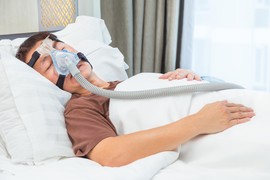Sleep apnea is a common sleep disorder that affects more than 18 million Americans. Untreated, the condition can lead to several negative health consequences. Physical therapy can help individuals with sleep apnea because cardiovascular exercise and physical activity have a positive impact on the symptoms of the disorder.
 To put this into perspective – as many as 1 in 5 adults suffers from mild symptoms of sleep apnea, and 1 in 15 adults suffer from moderate to severe symptoms. These estimates may be even higher considering the fact that sleep apnea is under-recognized and under-diagnosed. In fact, it is estimated that only 40% of individuals with obstructive sleep apnea have actually been diagnosed.
To put this into perspective – as many as 1 in 5 adults suffers from mild symptoms of sleep apnea, and 1 in 15 adults suffer from moderate to severe symptoms. These estimates may be even higher considering the fact that sleep apnea is under-recognized and under-diagnosed. In fact, it is estimated that only 40% of individuals with obstructive sleep apnea have actually been diagnosed.
To further complicate the numbers, the obesity epidemic in first world countries has the potential to drastically increase the number of individuals affected. Sleep apnea is a sleep disorder wherein an individual’s breathing is briefly and repeatedly disturbed during sleep. Most cases of sleep apnea are classified as obstructive sleep apnea whereby the muscles in the back of the throat do not keep the airway open during sleep, despite an individual’s effort to breathe. Central sleep apnea is far less common and occurs when the brain fails to control breathing during sleep. Sleep apnea can result in disturbed sleep and low blood oxygen levels.
The most notable indicator of sleep apnea is chronic snoring. Patients will commonly report excessive daytime sleepiness at work, or while driving, which can lead to an increased risk of injury and motor vehicle accidents. These symptoms are due to the sleep deprivation caused by sleep apnea. Other symptoms include difficulty concentrating, irritability, depression, sexual dysfunction, as well as memory and learning issues.
Unfortunately, untreated sleep apnea can result in numerous negative health consequences. Research has consistently demonstrated a clear link between sleep apnea and the development of hypertension, type II diabetes, cardiac arrhythmias, coronary artery disease, congestive heart failure, mood and memory issues, and early death.
If you suffer from symptoms of sleep apnea or your partner notices that you regularly snore, gasp, or choke during your sleep, it’s important to be evaluated by your doctor. One of the more common diagnosis methods is a sleep study which typically involves an overnight stay at a sleep clinic to monitor multiple aspects of your sleep including eye movement, respiratory effort, heart rate, air flow, blood oxygen levels and sleep state. The findings of your sleep study will help to diagnose sleep apnea and determine the severity of your condition.
The mainstay of treatment for sleep apnea is a continuous positive airway pressure device (CPAP). This device has a mask that is placed over the mouth and/or nose that blows air into the airway to help keep it open during your sleep cycle. However, not all patients tolerate CPAP and it is not suitable for patients with mild symptoms. This is where exercise can be beneficial. Research has shown that patients with obstructive sleep apnea that participate in regular, primarily aerobic based exercise programs, have a reduction in symptom severity, as well as decreased daytime sleepiness, increased sleep efficiency, and improved peak oxygen consumption.
If you suffer from symptoms of sleep apnea, physical therapy can help. Many factors can influence sleep apnea such as posture, body weight, sleeping position, spinal mobility, overall physical conditioning, nutrition, and how you plan and pace your daily activities. Undergoing a comprehensive evaluation by physical therapists at Iron City Physical Therapy is one of the best ways to gain an understanding of how your sleep apnea is affecting your health and what YOU can do to reduce the occurrence and impact of this condition. Your physical therapist can help you determine which modifiable health factors could be influencing your sleep apnea and create an individualized treatment plan that is tailored specifically to the severity of your condition. You will work with the physical therapist to set goals and track your progress as you work through your treatment plan towards improved health and function!
References
1. Kendzerska T, Gershon A, Hawker G, Leung R, Tomlinson G. Obstructive Sleep Apnea and Risk of Cardiovascular Events and All-Cause Mortality: A Decade-Long Historical Cohort Study. PLoS Med. 2014;11(2):e1001599. doi:10.1371/journal.pmed.1001599.
2. Sleep Apnea. Sleepfoundation.org. 2018. Available at: https://sleepfoundation.org/sleep-disorders-problems/sleep-apnea. Accessed April 9, 2018.
3. Motamedi KM, McClary AC, Amadee RG. Obstructive Sleep Apnea: A Growing Problem. The Ochsner Journal. 2009 Fall; 9(3): 149–153.
4. Knauert M, Naik S, Gillespie M, Kryger M. Clinical consequences and economic costs of untreated obstructive sleep apnea syndrome. World Journal of Otorhinolaryngology-Head and Neck Surgery. 2015;1(1):17-27. doi:10.1016/j.wjorl.2015.08.001.
5. De Andrade FMD, Pedrosa RP. The role of physical exercise in obstructive sleep apnea. Jornal Brasileiro de Pneumologia. 2016;42(6):457-464. doi:10.1590/S1806-37562016000000156.




